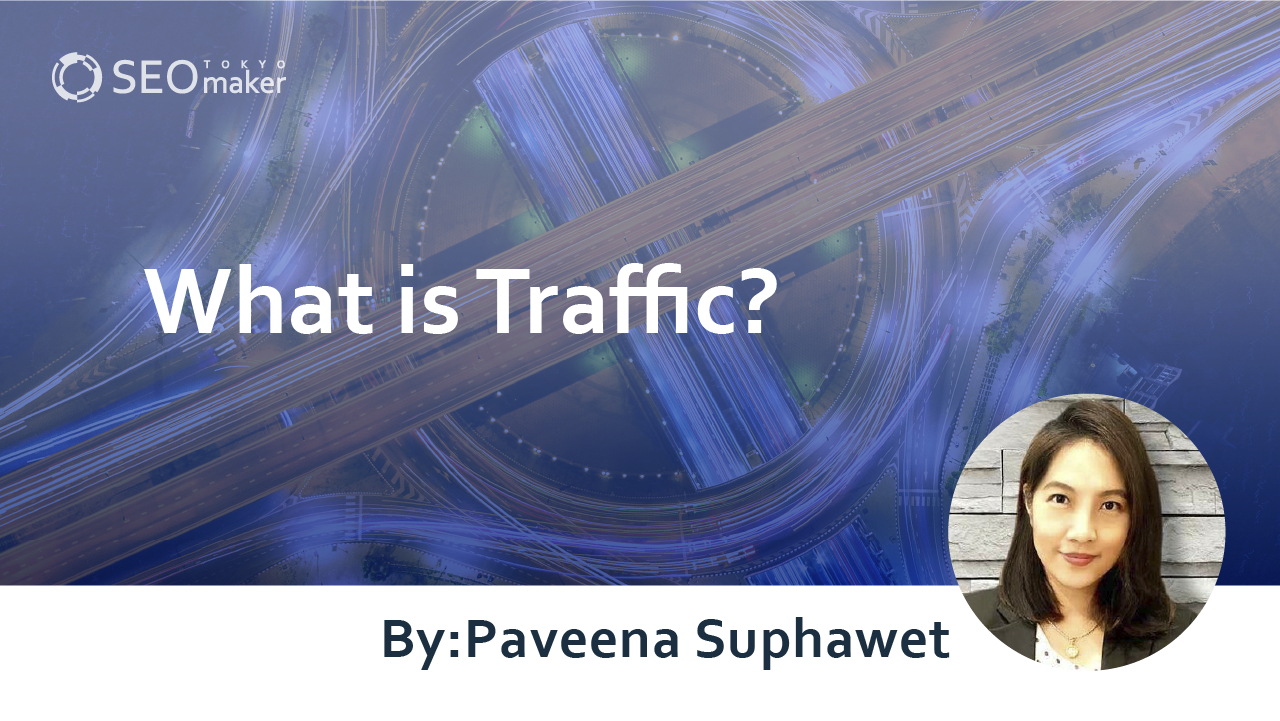What is Traffic? Explaining Types of Traffic and How to Increase It
contents

In recent times, effectively utilizing the web for sales and marketing has become crucial for boosting the revenue of your services or products.
One key strategy is increasing the search engine ranking to attract more users to your site—essentially increasing your traffic. The term ‘traffic,’ newly adopted in Google search rankings, refers to the number of visits a website or a specific webpage receives. Many people struggle to understand the exact definition of traffic, its types, and how to increase it.
Traffic means the number of accesses to a website or a specific webpage. Implementing SEO strategies can help improve the number of these visits. This article clearly introduces the types of traffic and various methods to increase it.
Understanding Traffic
Traffic refers to the number of accesses a website or a specific webpage gets. Analyzing the daily fluctuations in traffic can help enhance the site or improve telecommunications infrastructure.
For example, if a website selling concert tickets sees high traffic at specific times, enhancing network equipment can prevent issues like users being unable to view the site or purchase tickets.
Traffic can be categorized into three types based on the source of site inflow.
-No Referrer
-Search
-Referral Sites
No Referrer
A no referrer is when the source of site visitation cannot be identified. Possible reasons for being unable to identify the source of traffic include the following factors.
- Accessing from bookmarks (favorites)
- Directly entering the URL in a search engine
- Clicking on a URL in an email newsletter
- Accessing from a smartphone app
- Scanning a QR code
- Settings in security software or specific settings that do not send referrer information
- Accessing from an encrypted (https) site
A characteristic of no referrer traffic is that it often comes from existing customers who are already aware of the site.
For instance, if traffic comes from a newsletter sent to an email list you own, it is categorized as no referrer.
For existing customers, there is no need to spend on new advertising to gain traffic, which is a cost-effective feature.
Search
Search, quite literally, refers to site visits (accesses) that occur through search queries. These can be divided into paid “listing ads” and natural “organic search.”
Listing Ads
Listing ads are displayed in response to user-searched keywords and include the following types.
- PPC ads (e.g., on Google, Facebook, Yahoo)
- Banner ads
- Affiliate marketing
For instance, if you run an ad on Google Adwords for the keywords “Tokyo SEO,” the search results displayed might prompt a click and a site visit, thus generating traffic.
A characteristic of listing ads is that they incur a cost every time they are clicked. While this means ongoing expenses, the ability to set the duration, target audience, and ad copy for specific keywords allows for potentially high-quality traffic from users.
Organic Search
Organic search refers to the search results displayed for keywords that are not ads, often called “natural search” because they represent a pure form of visibility.
The items displayed include the following.
- Websites, pages
- Social media (Facebook, Twitter, Instagram)
- Blogs
- YouTube
- Video interviews
For example, a search for “Tokyo SEO” on Google would yield certain results. Clicks on these, leading to site visits, also generate traffic.
The key feature of organic search traffic is that if you can get your site to appear at the top of these results, you can expect a high number of visitors. Therefore, SEO (Search Engine Optimization) is crucial.
Referral Sites
Referral sites refer to accesses that come from sources other than search engines, typically through links in articles, blogs, or URLs in newsletters.
The characteristic of referral site traffic is that it allows for effective monitoring of how well link-based recruitment strategies are working. Additionally, based on the source of the inflow, it’s possible to analyze what interests visitors have and identify issues or areas for improvement.
Relation to SEO
The number of visits to a website is a critical metric considered part of SEO strategies aimed at improving search rankings.
A higher number of accesses often indicates to Google that a site is valuable to users, making increased traffic crucial. However, Google’s algorithms are constantly evolving, and simply encouraging repeated visits by the same users doesn’t affect site ranking and could potentially lead to penalties.
Thus, rather than just increasing the number of accesses, it’s important to focus on how long visitors stay on the same page (“site dwell time”) and how many pages unique users view within a particular website (“session count”). These have become important indicators.
Therefore, in managing a site, it’s essential to analyze where and when traffic originates and create valuable content for users, aiming to build a site with high usability.
Methods to Increase Traffic through SEO
As mentioned earlier, to increase traffic, it’s essential to employ SEO strategies to achieve higher rankings in organic search results. There are various ways to do this, and here we’ll introduce four effective methods.
-Providing Quality Content
-Site Improvement
-Data Analysis
-Leveraging Internal and External Media
Providing Quality Content
To rank higher, it’s crucial to regularly provide high-quality, original content that meets user needs.
For example, if someone searching for SEO techniques doesn’t find the needed information on one website, they’ll likely visit another site. If your content is valuable, it can lead them to read further and possibly take actions such as making inquiries, highlighting the importance of your content’s quality.
When creating content, it is key to clearly define the purpose of creation and consider the following points during production.
- Ensure consistency
- Provide high-quality content related to your products or services
- Cover a variety of topics
- Consider SEO implications
|
Purpose |
Details for Content Creation |
|
Awareness |
Write articles on themes related to but not directly connected to your products to raise awareness. |
|
Interest/Engagement |
Create articles that introduce products directly related to or address common concerns, fostering interest and engagement. |
|
Consideration |
Develop articles useful for the comparison and evaluation stage, helping readers make informed decisions. |
|
Purchase/Action |
Write articles that resolve issues or answer questions about products, guiding readers towards making a purchase or taking action. |
|
Loyalty |
Post-purchase, write articles on how to use the products effectively, benefiting existing customers and also providing value to non-customers. |
|
Sharing |
Produce content that readers will want to share, such as unique insights or valuable data within the industry. |
The content creation process involves setting a persona, clarifying the purpose of the content, creating a customer journey, selecting relevant keywords, and then writing. After publication, tools like Google Analytics and Google Search Console can analyze various metrics such as search keywords, ranking positions, page sessions, bounce rates, and time spent on site to ensure the content meets user needs.
After publishing content, you can use tools like Google Analytics and Google Search Console to analyze the following elements and verify if the content meets user demands.
- Search Keywords
- Ranking Position
- Number of Page Sessions within the Site
- Bounce Rate within the Site
- Time Spent on the Site
Based on this analysis, you can revise (rewrite) the content to better align with user needs.
Focusing on quality in content creation and making improvements through rewriting are essential. However, another key strategy to increase traffic is to convert visitors into repeat visitors (fans). To encourage return visits, it’s important to provide enough content during a single visit so that users can’t consume it all at once. If visitors recognize the value of your site, they are more likely to return.
Site Improvement
To make a site attractive to visitors, it’s necessary to create engaging titles and eye-catching images, optimize internal links, and enhance user experience (UX).
Particularly, a metric known as “Core Web Vitals”, one of user experience (UX), has been gradually integrated into Google’s ranking algorithms since 2021. Therefore, optimizing page loading speeds has become a critical element.
To make a site more attractive, ensuring clear and understandable titles and descriptions for search keywords can make it easier to attract visits.
Practical considerations for preventing users from leaving your site include optimizing for smartphones, using eye-catching images, adjusting text size, managing text amount, content length, page design, and strategically placing CTAs.
For instance, if a user searching for SEO services in Tokyo lands on a page, having a readily accessible download button for company information at the right spot can be effective.
Additionally, strategically placing internal links within your content strategy is crucial for improving search rankings.
This involves creating multiple articles on a single topic, each focusing on specific content, thereby strengthening the topic’s presence in Google searches and improving search rankings.
Data Analysis
Data analysis consists of two main types, analyzing competitor websites and analyzing your own website.
For competitor website analysis, we examine the marketing channels used by competitors to identify channels where they are not heavily invested. By focusing on these areas, we can increase our traffic.
In analyzing our own site, we use tools like Google Analytics to assess how users access our site and identify areas for improvement to increase traffic.
Leveraging Internal and External Media
To boost traffic, it’s necessary to effectively use not just Google but also social networks like Instagram, Twitter, Facebook, YouTube, and TikTok. Here are three strategies.
-Utilizing Social Media and Advertising
-Promoting through Webinars
-Employing Influencer Marketing
Utilizing Social Media and Advertising
Increasing traffic through posts and advertisements on social media platforms is effective.
Especially on social media, where you can interact directly with users, actively respond to any questions related to your products or services, and share your site’s URL when necessary. The key is to create valuable posts that people want to share.
You can also target specific demographics with ads on platforms like Instagram and Facebook. For BtoC business models, Instagram ads are particularly noteworthy for increasing traffic because of Instagram’s ability to deliver brief, engaging video content and its AI-driven customization of ads to individual users.
Promoting through Webinars
For BtoB business models, webinars are highly effective for attracting potential customers. Sharing your site’s URL during free webinars can significantly increase visits.
Additionally, publishing URLs in various seminar materials and offering exclusive content to survey respondents post-seminar can also drive site visits.
Employing Influencer Marketing
Influencer marketing involves partnering with influencers on platforms like Instagram, YouTube, and TikTok, who have significant reach, to introduce your products or services. This communication strategy aims to shift consumer attitudes and behaviors. Influencers can be categorized based on their follower count into nano (under 1,000 followers), micro (1,000 to 100,000 followers), macro (over 100,000 followers), and mega (over 1 million followers), each requiring a different strategic approach.
While influencer marketing is a potent strategy to increase traffic, selecting the right influencers can be challenging and carries the risk of potential backlash. Therefore, it’s crucial to weigh the pros and cons carefully.
How to Check Traffic
To ensure that your SEO efforts are paying off, it’s crucial to regularly check the results and assess whether your traffic is increasing.
One method to monitor traffic is by using Google Analytics to analyze the status of your website. Based on the analysis, it’s essential to identify and address any bottlenecks. Here are three key points to check.
User Demographics (such as device usage, gender, location)
First, check the number of site visits. If there are sudden increases or decreases in traffic, investigate the causes.
Verification Method > Overview of User Visits: Displayed by selecting ‘User’ > ‘Overview’
Additionally, you can check the list of attributes for search users linked to a Google account.
This allows you to verify demographics such as gender and age, enabling improvements like modifying the site design and text to resonate more with frequent visitors.
Inflow Paths to the Page (such as search, ads, links)
There are several sources of web page traffic, including direct, no-referrer, search (direct and ads), and referral sites. These are displayed in categories as below.
-
- Organic Search: Inflow from search engines like Google or Yahoo!
- Paid Search: Inflow from listing ads
- Display: Inflow from display ads
- Social: Inflow from social media
- Direct: Direct visits such as through bookmarks
- Referral: Inflow from other sites
- Email: Inflow from email campaigns
- Affiliates: Inflow from affiliate links
- Other Advertising: Inflow from other advertising methods
- Other: Unclassifiable sources
Verification Method > Source of User Traffic: Displayed by selecting ‘Acquisition’ > ‘All Traffic’ > ‘Channels’
Analyzing the number of accesses and conversion rates from each source allows for targeted improvements.
For example, if ads are running but not generating increased traffic, it might be necessary to revisit and adjust the keywords or targeting criteria for your campaigns.
By analyzing which media sources have more or less traffic, you can consider improvements tailored to each medium.
User Behavior Flow (movement between pages, time spent, etc.)
You can analyze access data for individual pages or directories and identify which pages users are exiting from. Additionally, the ‘Behavior Flow’ feature shows the sequence in which users navigate through the site and allows checking the time spent on each page.
Verification Method > Displayed by selecting ‘Behavior’ > ‘Site Content’ > ‘All Pages’
Pages with short average visit times or high bounce rates might need content rewrites to improve. Conversely, you might enhance content on pages where users spend more time to further engage their interests.
Summary
“Traffic” refers to the number of site accesses, and this article has introduced an overview and methods to increase traffic. Effective SEO involves creating quality content that matches the search intent of frequently searched keywords. Additionally, maintaining regular updates to news sections and blogs is essential, so it’s important to have a solid operational plan and improvement workflow in place. If you have concerns about SEO, feel free to consult with Tokyo SEO Maker.










![What is a Description? Explaining the Meaning, Writing Style, and Changing Word Count – [2023 Edition]](https://www.switchitmaker2.com/en/wp-content/uploads/2024/09/what-is-description.webp)










